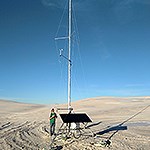
R. Burghart Photo As stewards of our nation’s natural and cultural resources, it is incredibly important that we know the impact of environmental factors that contribute to or threaten the integrity of this landscape. Understanding the complex and interconnected relationships between climate change, stabilized environmental conditions, native and non-native species, and pollution can provide the tools necessary for the preservation and protection of natural and cultural protected within White Sands National Park. It is critical to understand the natural systems within the park in order to identify threats to the resources. Continue reading to understand how the unique environment here at White Sands has equally unique contributing environmental factors. 
NPS Photo The spread of invasive species is recognized as one of the major factors contributing to ecosystem change and instability throughout the world. Here at White Sands, invasive species are certainly changing our landscape. African oryx trample native plants and create numerous game trails. Tamarisk (salt cedar) can soak up hundreds of gallons of water a day, choking out native vegetation. Other non-native plants, like the Russian thistle and African rue, also grow in the area. These invasive species affect the native ecosystems at White Sands and pose a challenge to preserving the park'snatural environment. 
NPS Photo Climate Change |
Last updated: January 30, 2020
